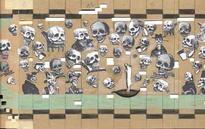JAN VROMMAN - DE EERSTE TREDE (‘THE FIRST STEP’)
EXHIBITION
The work of Jan Vromman dissociates itself from any artistic categorisation and stylistic development. He is not actively concerned with the creation of an oeuvre; he rather makes an impulsive use of wide ranging styles and gestures. His subjects are found in his own environment, with his own language, customs, myths and trifles. The universal is embedded in the intimacy of the local and the everyday life. Even though he is active within the artistic and economic context of video and film, he strives to steer clear from the inherent mechanisms and to row against the tide of standardisation and dogmatism, which is also penetrating the arts sector.
The exhibition project De Eerste Trede (‘The First Step’) hardly wishes to concern itself with art judgement. Whether art is reviewed and laurelled or not, it is of no importance. Vromman wants to treat art practise as an ‘act in itself’, irrespective of the result. He cherishes them all, these artists, who roam through the ‘city of ideas’, chests out and shoulders back, with a keen gaze. Including those who resign themselves to the lower steps of the ladder of perfection, who lend weight to their creative urges, who justify the futile, with wide gestures and ponderous words. They all meet on the first step – the will to break away from the commonplace, to contemplate and to recount.
From a child Jan Vromman was already immensely fascinated by those who were bestowed with the ‘artist’ hallmark, their vigour, the hint of non-conformism. On a screen he talks about these innumerable encounters, this admiration which shaped his youth, ultimately arousing ‘the artist’ inside him. The loss of candour, also, the confusion at the evaporating guiltless perspective on art as pure and immaculate, far removed from immovable market mechanisms. A handful of bittersweet memories, a cross-section in time.
A second module in the exhibition also reflects on the work of ‘the’ artist. A map to a city area and seven video screens are linked to each other. On each of the screens an artist discusses his passion for ‘creating’. They remain anonymous; none of their artworks are shown. The map marks out a reference to their place of residence, within a three kilometre radius of Vromman’s house. Location alone is the selection criterion, as a cross-section in space.
To Vromman telling a story is a way of offering resistance - “An evil story can only be contended with a good story”, he claims. The many observations and reflections he makes on micro level betray an almost childlike sense of commitment, a conviction that little things carry greatness in them. The recounting, capturing and communicating of these little, at times furtive, ideas and images hides unconstrained directions and statements, simultaneously critical and tender. Precisely in this explicit naiveté, more than once fixing itself in the visual language as well, the catalyst moves towards a personal mode of storytelling, pushed forward by enthusiasm rather than style.
Vromman looks for greatness in tiny things. Bustling over the idea, the institute of art is put into perspective through a multitude of genres and shapes. His universe aims towards being a ‘multiverse’, influenced by his experiences in the city, where he wrought himself from the oppressing world of his youth. This crossroad of notions and cultures, splintered yet all-encompassing reality, contains a resistance to any concentration of power. The DVD De stoel waarop ik zit (‘The chair I sit upon’), which will be permanently presented in the Black Box during the exhibition, comprises a series of older and new audio-visual stories. Together they constitute a single world view – a way of perceiving and contemplating. It is investigated how little stories can radiate greatness, stubbornness and independence, but simultaneously find a meaning in the sum of their parts. Unity emerges out of multitude. The visitor can move freely through the DVD. By the choices he makes, he actively writes a variation of his own on this great story.
During the exhibition the 20-metre drawing, created by Luk Gobyn for the DVD, will also be shown. A story on cardboard, painted on a music sheet for a barrel organ and accompanied by a composition by Dick van der Harst, is here liberated from its ‘video-existence’.

-
za 15.11.2003
- za 17.1.2004
-
Praktische info
Location:
argos
Opening hours:
Tuesday to Saturday, 12:00 to 19:00
Entrance fee:
free - Kunstenaars
- Werken
-
ARGOS PUBLICATIES